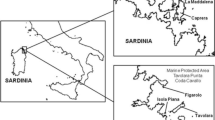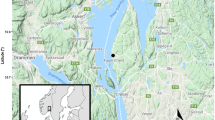Abstract
In this paper we establish the best period for sampling moth communities within the first half of the night. We stress the importance of sampling duration in ecological studies that use moths as an indicator taxon, because sample composition changes throughout the night due to individual species flight behaviour. A total of 20,744 individuals belonging to 562 species were analysed using diversity and similarity indices. Between-site sub sample comparisons were found to have low discriminant ability when they included the first hour of the night. Moreover, the moth community sampled at this time showed a low identity with other sampled portions of the same community, probably because generalist species were present in all the four surveyed sites at this time. In order to minimise sampling bias, we suggest using three hour-long surveys when the first hour after dusk is included in the sample, using Fisher’s α for diversity ranking when different sampling durations are used at different sites.


Similar content being viewed by others
Explore related subjects
Discover the latest articles and news from researchers in related subjects, suggested using machine learning.References
Barlow HS, Woiwod IP (1989) Moth diversity of a tropical forest in Peninsular Malaysia. J Trop Ecol 5:37–50
Bowden J (1982) An analysis of factors affecting catches of insects in light-traps. Bull Entomol Res 72:535–556
Brehm G, Axmacher JC (2006) A comparison of manual and automatic moth sampling methods (Lepidoptera: Arctiidae, Geometridae) in a rain forest in Costa Rica. Environ Entomol 35:757–764
Brehm G, Fiedler K (2005) Diversity and community structure of geometrid moths of disturbed habitat in a montane area in the Ecuadorian Andes. J Res Lepid 38:1–14
Chazdon RL, Colwell RK, Denslow JS, Guariguata MK (1998) Statistical methods for estimating species richness of woody regeneration in primary and secondary rain forests of northeastern Costa Rica. In: Dallmeier F, Comisky JA (eds) Forest biodiversity research, monitoring and modelling: conceptual background and world case studies. Parthenon Publishing, Paris, pp 285–309
Colwell RK (2005) EstimateS: statistical estimation of species richness and shared species from samples. Version 7.5. Persistent URL: purl.oclc.org/estimates
Conrad KF, Woiwod IP, Parsons M, Fox R, Warren MS (2004) Long-term population trends in widespread British moths. J Insect Conserv 8:119–136
Conrad KF, Warren MS, Fox R, Parsons M, Woiwod IP (2006) Rapid declines in common moths underscore a biodiversity crisis. Biol Conserv 132:279–291. doi:10.1016/j.biocon.2006.04.020
Delisle J, West RJ, Bowers WW (1998) The relative performance of pheromone and light traps in monitoring the seasonal activity of both sexes of the eastern hemlock looper, Lambdina fiscellaria fiscellaria. Entomol Exp Appl 89:87–98. doi:10.1023/A:1003450432755
Edwards DK (1962) Laboratory determinations of the daily flight times of separate sexes of some moths in naturally changing light. Can J Zool 40:371–510. doi:10.1139/z62-032
Fay HAC, Halfpapp KH (1999) Activity of fruit-piercing moths, Eudocima spp. (Lepidoptera: Noctuidae), in north Queensland crops: some effects of fruit type, locality and season. Aust J Entomol 38:16–22. doi:10.1046/j.1440-6055.1999.00072.x
Fisher RA, Corbet A, Williams CB (1943) The relation between the number of species and the number of individuals in a random sample of an animal population. J Anim Ecol 12:42–58. doi:10.2307/1411
Fullard JH, Ratcliffe JM, Soutar AR (2004) Extinction of the acoustic startle response in moths endemic to a bat-free habitat. J Evol Biol 17:856–861. doi:10.1111/j.1420-9101.2004.00722.x
Hayek L-A, Buzas MA (1997) Surveying natural populations. Columbia University Press, New York
Hodkinson ID (2005) Terrestrial insects along elevational gradients: species and community responses to altitude. Biol Rev Camb Philos Soc 80:489–513. doi:10.1017/S1464793105006767
Intachat J, Woiwod IP (1999) Trap design for monitoring moth biodiversity in tropical rainforests. Bull Entomol Res 89:153–163. doi:10.1017/S0007485399000243
Janzen DH (1984) Two ways to be a tropical big moth: Santa Rosa saturniids and sphingids. Oxf Surv Evol Biol 1:85–140
Kempton RA, Taylor LR (1974) Log-series and log-normal parameters as diversity discriminants for the Lepidoptera. J Anim Ecol 43:381–399. doi:10.2307/3371
Kitching RL, Orr AG, Thalib L, Mitchell H, Hopkins MS, Graham AW (2000) Moth assemblages as indicators of environmental quality in remnants of upland Australian rain forest. J Appl Ecol 37:284–297. doi:10.1046/j.1365-2664.2000.00490.x
Lewis T, Taylor LR (1965) Diurnal periodicity of flight by insects. Trans R ent Soc Lond 116:393–469
Luff ML, Woiwod IP (1995) Insect as indicators of land-use change: a European perspective, focusing on moths and ground beetles. In: Harrington R, Stork NE (eds) Insects in a changing environment. Academic Press, London, pp 399–422
Luque C, Gers C, Lauga J, Mariano N, Wink M, Legal L (2007) Analysis of forestry impacts and biodiversity in two Pyrenean forests through a comparison of moth communities (Lepidoptera, Heterocera). Insect Sci 14:323–338. doi:10.1111/j.1744-7917.2007.00159.x
Magurran AE (2004) Measuring biological diversity. Blackwell Publishing, Oxford
Mikkola K (1972) Behavioural and electrophysiological responses of night-flying insects, expecially Lepidoptera, to near-ultraviolet and visible light. Ann Zool Fenn 9:225–254
New TR (2004) Moths (Insecta: Lepidoptera) and conservation: background and perspective. J Insect Conserv 8:79–94
Ricketts TH, Daily GC, Ehrlich PR, Fay JP (2001) Countryside biogeography of moths in a fragmented landscape: biodiversity in native and agricultural habitats. Conserv Biol 15:378–388. doi:10.1046/j.1523-1739.2001.015002378.x
Saito O (2000a) Flight activity of three Spodoptera spp., Spodoptera litura, S. exigua and S. depravata, measured by flight actograph. Physiol Entomol 25:112–119. doi:10.1046/j.1365-3032.2000.00172.x
Saito O (2000b) Flight activity changes of the cotton bollworm, Helicoverpa armigera (Hübner) (Lepidoptera: Noctuidae), by ageing and copulation as measured by flight actograph. Appl Entomol Zool (Jpn) 35:53–61. doi:10.1303/aez.2000.53
Scalercio S (2004) Caratterizzazione della comunità dei macrolepidotteri eteroceri fototropici della pino-abetina di Monte Cocuzzo (Calabria, Italia). Atti del XIX Congresso Nazionale Italiano di Entomologia, Catania 10–15 giugno 2002, 237–242
Scalercio S, Iannotta N, Brandmayr P (2007) The role of semi-natural and abandoned vegetation patches in sustaining lepidopteran diversity in an organic olive orchard. Bull Insectology 60:13–22
Scalercio S, Infusino M (2003) I Macrolepidotteri di fosso Scuotrapiti, lago dell’Angitola (Calabria, Italia meridionale) (Lepidoptera). Phytophaga 13:25–52
Scalercio S, Infusino M (2006) I Macrolepidotteri notturni del basso corso della Fiumara del Trionto (Calabria, Italia meridionale) (Lepidoptera) Quaderni della Stazione di Ecologia. Civico Museo Stor Naturale Ferrara 16:179–202
Scalercio S, Infusino M, Tuscano J (2008) I Macrolepidotteri notturni della faggeta di Monte Curcio, Sila Grande (Calabria, Italia meridionale) (Lepidoptera) Quaderni della Stazione di Ecologia. Civico Museo Stor Naturale Ferrara 18:5–19
Summerville KS, Crist TO (2003) Determinants of lepidopteran community composition and species diversity in eastern deciduous forests: roles of season, eco-region and patch size. Oikos 100:134–148. doi:10.1034/j.1600-0706.2003.11992.x
Summerville KS, Ritter LM, Crist TO (2004) Forest moth taxa as indicators of lepidopteran richness and habitat disturbance: a preliminary assessment. Biol Conserv 116:9–18. doi:10.1016/S0006-3207(03)00168-X
Summerville KS, Crist TO (2005) Temporal patterns of species accumulation in a survey of Lepidoptera in a beech-maple forest. Biodivers Conserv 14:3393–3406. doi:10.1007/s10531-004-0546-x
Süssenbach D, Fiedler K (1999) Noctuid Moths attracted to fruit baits: testing models and methods of estimating species diversity. Nota lepid 22:115–154
Taylor LR, French RA (1974) Effects of light-trap design and illumination on samples of moths in an English woodland. Bull Entomol Res 63:583–594
Taylor LR, Kempton RA, Woiwod IP (1976) Diversity statistics and the log-series model. J Anim Ecol 45:255–271. doi:10.2307/3778
Usher MB, Keiller SWJ (1998) The Macrolepidoptera of farm Woodlands: determinants of diversity and community structure. Biodivers Conserv 7:725–748. doi:10.1023/A:1008836302193
Waring P (1994) Moth traps and their use. Br Wildl 5:136–139
White EG (1991) The changing abundance of moths in a tussock grassland, 1962–1989, and 50- to 70-year trends. N Z J Ecol 15:5–22
Williams CB (1935) The times of activity of certain nocturnal insects, chiefly Lepidoptera, as indicated by a light trap. Trans R ent Soc Lond 83:523–555
Wunderer H, De Kramer JJ (1989) Dorsal ocelli and light-induced diurnal activity patterns in the arctiid moth Creatonotos transiens. J Insect Physiol 35:87–95. doi:10.1016/0022-1910(89)90041-3
Acknowledgments
The critical comments of two anonymous reviewers helped us improve this manuscript. Work was supported financially by the Museo di Storia Naturale della Calabria e Orto Botanico, Italy, president prof. P. Brandmayr. Rothamsted Research receives grant-aided support from the UK Biotechnology and Biological Sciences Research Council.
Author information
Authors and Affiliations
Corresponding author
Rights and permissions
About this article
Cite this article
Scalercio, S., Infusino, M. & Woiwod, I.P. Optimising the sampling window for moth indicator communities. J Insect Conserv 13, 583–591 (2009). https://doi.org/10.1007/s10841-008-9206-x
Received:
Accepted:
Published:
Issue Date:
DOI: https://doi.org/10.1007/s10841-008-9206-x




